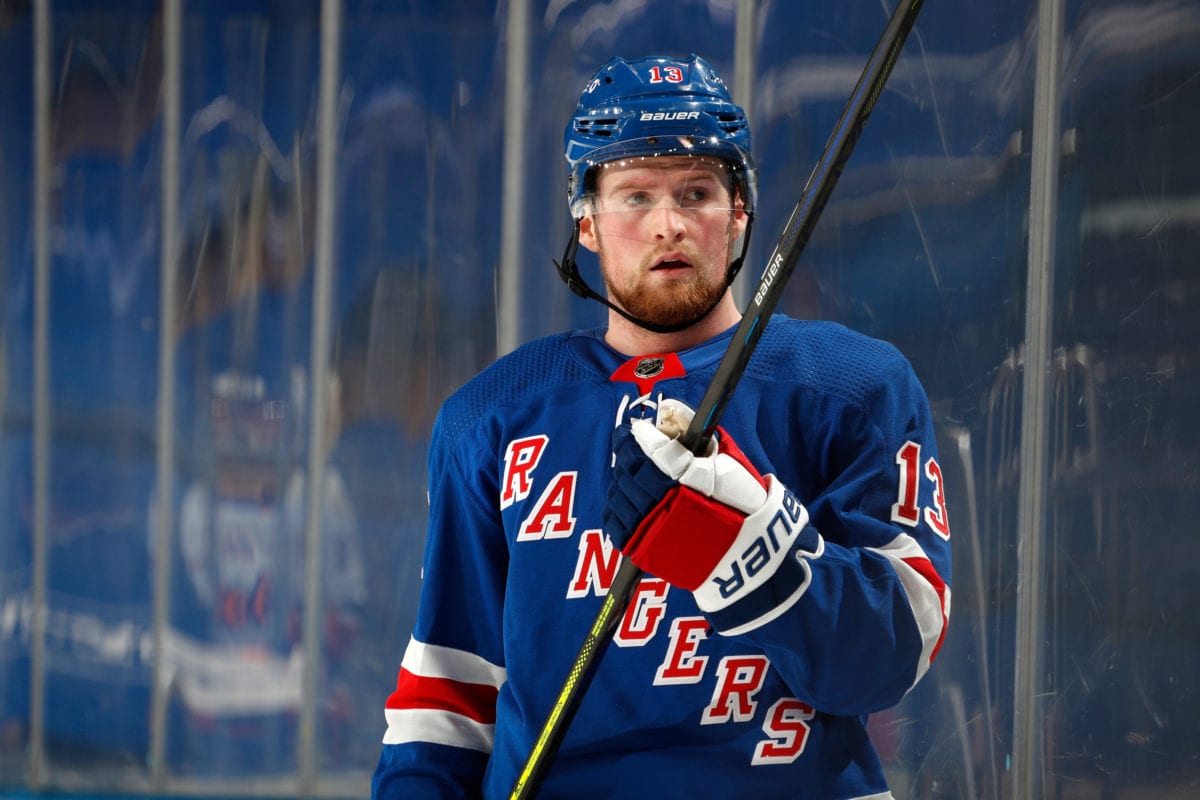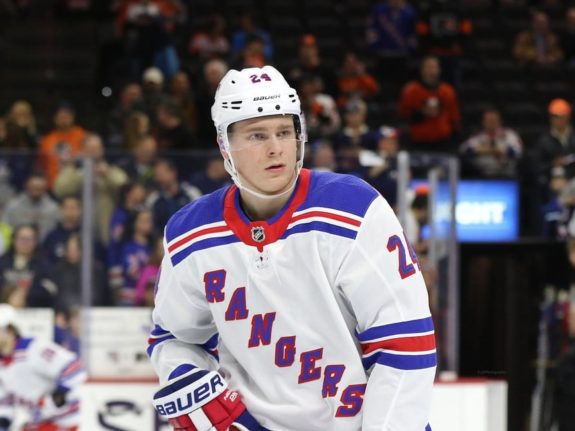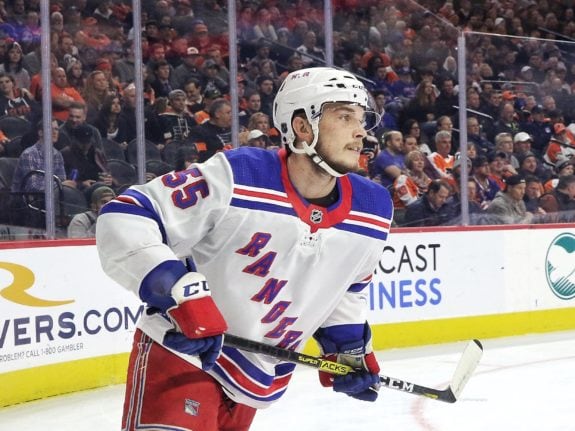The New York Rangers rolled into last Sunday’s opener of a two-game road set against the Pittsburgh Penguins flying high. Three straight wins for the first time this season and six victories in eight games had pushed them to 10-9-3. They had scored six goals three times during that stretch and were overcoming the absence of Artemi Panarin with timely offense from throughout the lineup.
They were ready to make a run and take the next step toward a playoff spot, right? As the past three games have shown, that 6-2-0 surge was something of a mirage.
Reality rudely intervened for the Blueshirts in the pair against the Pens and the opener of another road two-gamer against the Boston Bruins, with the Rangers getting outscored 13-3 in a trio of largely uncompetitive losses. The most recent, Thursday’s lifeless 4-0 defeat to the B’s, was probably their worst of the season and emphatically demonstrated the size of the gap between the young Rangers and a tough, resilient veteran outfit like Boston.

“I think we have to have more urgency and understand how quickly this season is going to come upon us,” said coach David Quinn, whose team’s 10-13-2 record is its worst 25-game mark since the 2002-03 Rangers had identical results. “We’ve got to make sure we stop the bleeding.” (From ‘Rangers’ Struggles Continue in Shutout Loss to Bruins’, New York Post, 3/11/21)
Stopping the bleeding, though, is an acquired skill. It’s learned, not bestowed as a bonus along with elite hockey talent. And the Blueshirts’ inability to do that over the past three contests, along with other clear signs, demonstrates that the romantic notion of a quick roster teardown, acquisition of exciting young players and rise back to contention in short order isn’t the way it works when it comes to total rebuilds.
Rangers Rebuild Still Requires Plenty of Patience
The truth is that walking that path sometimes means peeks of sunshine interspersed with many more cloudy days. A young team can look like world-beaters one week and bottom-feeders the next. Developing consistency and avoiding deep valleys amidst the ebb and flow of a long NHL season requires experience and growth, not just talent.
What should be brutally obvious from the past seven days is that this project, contrary to what many fans may have believed, has a long way to go before it bears fruit in the form of a consistent playoff contender.
It’s not worth listing all of the players who came up small during the three-game skid, because it was kids and veterans alike. Something is still missing here, something that can only be gained with time and game reps that will stretch beyond this season.

Matchups with the Big Bad Bruins should be particularly revealing. There’s little doubt the Baby Blueshirts are intimidated by their neighbors to the northeast, as they’ve been almost completely ineffective at containing and matching Boston’s steamroller top line of Brad Marchand, Patrice Bergeron and David Pastrnak. The Bruins have won four of five matchups this season.
It’s more than that, however. The Bruins have focused on bullying the Rangers with their size and grit, turning loose big forwards Nick Ritchie, Trent Frederic and others to push around a Blueshirts roster that lacks the personnel to push back. Defenseman Ryan Lindgren, in particular, has become a prime target for Boston as the B’s look to close down one of the few Rangers who plays an in-your-face style.
The organization has been negligent in protecting its star players for years – see McDonagh, Ryan – and a trade for a legitimate enforcer is way past due. Prying Ryan Reaves, one of the best in the business who as a bonus happens to be the long-time nemesis of Washington Capitals tough guy/intimidator Tom Wilson, away from the Vegas Golden Knights would solve a host of problems. Such a presence would provide a comfort level to the teenagers and 20-somethings on the Blueshirts’ roster that are trying to learn how to play in the NHL without being knocked all over the place.

“You need those guys,” said Anaheim Ducks defenseman Kevin Shattenkirk, the former Ranger who lifted the Stanley Cup as a member of the Tampa Bay Lightning last season. “You need guys that are going to have a little bit of sandpaper. I think what it also does is it allows your skilled players to realize that they have a little protection out there. They have guys that are going to stick up for them if other teams are trying to take liberties and run around and try to intimidate you.”
The problem goes beyond adding one player, however. The Rangers may well have to remake part of their roster with toughness someday, as so many teams have in order to take the next step toward championship contention. But the kids will also have to learn how to stand up to this kind of challenge as a team, and that takes time – sometimes considerably more than an impatient fan base is willing to tolerate.
Lightning’s 12-Year Odyssey Might Be Instructive for Rangers
Take the defending champs. The Lightning, in full rebuild mode after capturing the Cup in 2003-04, drafted Steven Stamkos first overall in 2008 and Victor Hedman second in 2009. They added Nikita Kucherov in the second round in 2011. Andrei Vasilevskiy was picked 19th overall in 2012. More recently, Mikhail Sergachev, Brayden Point and McDonagh came aboard via trade or the draft.
Yet, despite all the star power, it took Tampa Bay 12 years from the start of that process to win another championship. Along the way, there was plenty of frustration in the form of near-misses, including a loss in the 2015 Stanley Cup Final, defeats in the Eastern Conference Final in 2011, 2016 and 2018, and a sweep at the hands of the Columbus Blue Jackets in the first round after winning the Presidents’ Trophy in 2019.
It was only when the Lightning realized that they needed to focus on defending and committed to a straight-line, gritty approach that they were able to reach the top of the mountain. Their transformed identity, along with size and physicality that was added for their Cup run, proved to be the difference.

The Rangers are a long way from the phase of needing to add complementary players for a deep postseason run. They’re loaded with upside and possibility but don’t come close to resembling a playoff team at this point.
It’s possible that the exciting part of the building process – the adding of young future cornerstones – might be largely complete. That’s taken three-plus years, but now comes the period when patience will really be required in spades – the portion of the program when those players learn how to win. That’s almost always painful, and often drawn-out.
Quinn’s club is sure to keep riding the rollercoaster for the foreseeable future – unbeatable one night, feeble the next. Fans need to buckle up. It’s probably going to be stomach-churning for some time.